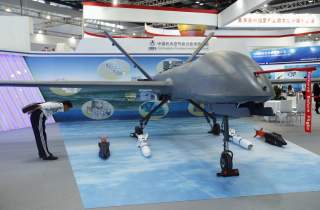by David Axe
 Key point: Everyone wants drones these days, but sometimes it is worth buying American. That's what some countries are finding out the hard way.
Key point: Everyone wants drones these days, but sometimes it is worth buying American. That's what some countries are finding out the hard way.
China’s CH-4 killer drone appears to be falling out of favor with some of its major operators.
This first appeared in August 2019 and is being reposted due to reader interest.
The Iraqi air force is down to just one operational CH-4 out of a fleet of around 10, according to an August 2019 report from the U.S. inspector-general.
Combined Joint Task Force Operation Inherent Resolve, the U.S.-led operation targeting Islamic State militants in Iraq and Syria, told the inspector-general that maintenance problems have grounded most of the Iraqi CH-4s.
The CH-4 is roughly similar to the U.S.-made MQ-1 Predator. The Chinese unmanned aerial vehicle, which is remotely-controlled via satellite and can carry a variety of missiles, briefly was popular among Middle East militaries that balked at the cost, politics and paperwork associated with acquiring armed drones from the United States.
But the Chinese drones seem to be going out of style. The Jordanian air force in June 2019 put up for sale its own six CH-4s.
Israel officially hands over Jericho to Palestinian control.
William Buckley, the CIA station chief in Beirut, Lebanon, is kidnapped by Islamic fundamentalists and later died in captivity.
It’s unclear why Amman is trying to get rid of its CH-4s just three years after acquiring them. But it’s possible the divestment is related to Jordan’s ongoing efforts to source Predator-style drones from the United States.
Jordan bought the missile-armed CH-4s around 2016 after the administration of U.S. president Barack Obama rejected Amman’s request for MQ-1s.
General Atomics also makes the larger MQ-9 Reaper drone.
The Jordanian air force’s No. 9 Squadron operated the Chinese-made drones. The same unit operates the air force’s other unmanned aerial vehicle, including Schiebel S-100 Camcopters and Leonardo Falcos.
It wasn’t until May 2018 that the Jordanian air force displayed a CH-4 in public.
“Marketed by Aerospace Long-March International Trade, the CH-4B has found a good market here in the Middle East, in part due to the reluctance of U.S. authorities to sell armed UAVs to their allies in the region,” Al-Monitor reported.
“Egypt, Saudi Arabia, the United Arab Emirates and Iraq have all acquired the CH-4B armed version, and the type has been employed widely on operations in Yemen and against [ISIS] targets in Iraq.”
But Jordan never gave up trying to get permission to buy American drones, which are widely considered as having better sensors, weapons and communications links than the Chinese drones do.
Amman perhaps believes Pres. Donald Trump is more open to approving drone sales to Middle East customers, not only for the military benefit but also as a way of commercially competing with China.
“The Donald Trump administration is worried that weapons carrying the ’Made in China’ label are becoming ubiquitous on Middle East battlefields,” Al-Monitor explained.
In increasing numbers, traditional U.S. allies are turning to Beijing for technologies that the United States is constrained from exporting as a signatory of international arms control treaties. The Pentagon is increasingly concerned that China’s growing arms sales give the country more clout to secure an economic and military foothold and relationships with U.S. allies in a region where defense officials often control the purse strings.
"It's potentially a tool for them to develop closer defense and military ties, particularly for future access,” Assistant Secretary of Defense for Indo-Pacific Affairs Randall Schriver told Al-Monitor at a recent Pentagon briefing. “China is less disciplined, and so there's a proliferation risk as well to regimes that we would regard as not necessarily responsible.”
Of course, it’s also possible that Jordan aims to replace the CH-4s with better Chinese-made drones.
Based on customers’ experience deploying the CH-4, drone-maker China Aerospace Science and Technology Corporation developed the larger and more powerful CH-5.
“The CH-5 offers a … 441-pound internal payload for sensors and a … 2,205-pound external payload, permitting it to carry up to 16 precision-guided missiles underwing,” Jane’s reported. “This vehicle is roughly equivalent to the MQ-9 Reaper, although it retains a piston engine instead of the Reaper’s turboprop.”
In Iraq at least, the CH-4 is not unique in suffering maintenance woes.
Alongside the Chinese-made CH-4s, Iraq also acquired 10 smaller ScanEagle drones from U.S. manufacturer Insitu.
But according to inspector-general, the ScanEagles flew just two sorties between March and June 2019 owing to a "combination of Iraqi training in the United States, a lapse in maintenance contracts and problems with signal interference.”
David Axe serves as Defense Editor of the National Interest. He is the author of the graphic novels War Fix, War Is Boring and Machete Squad. This first appeared in August 2019 and is being reposted due to reader interest.
No comments:
Post a Comment